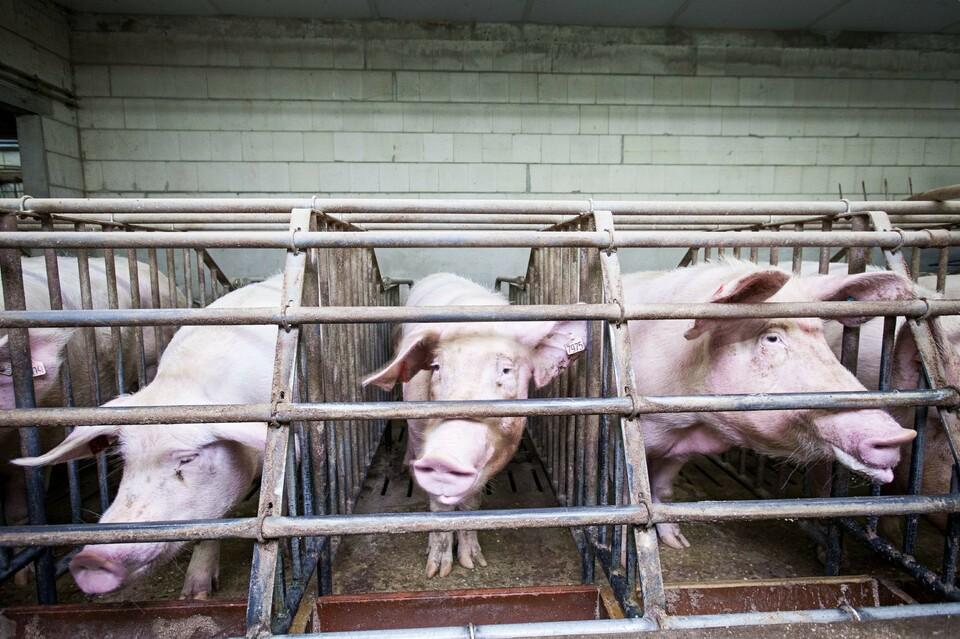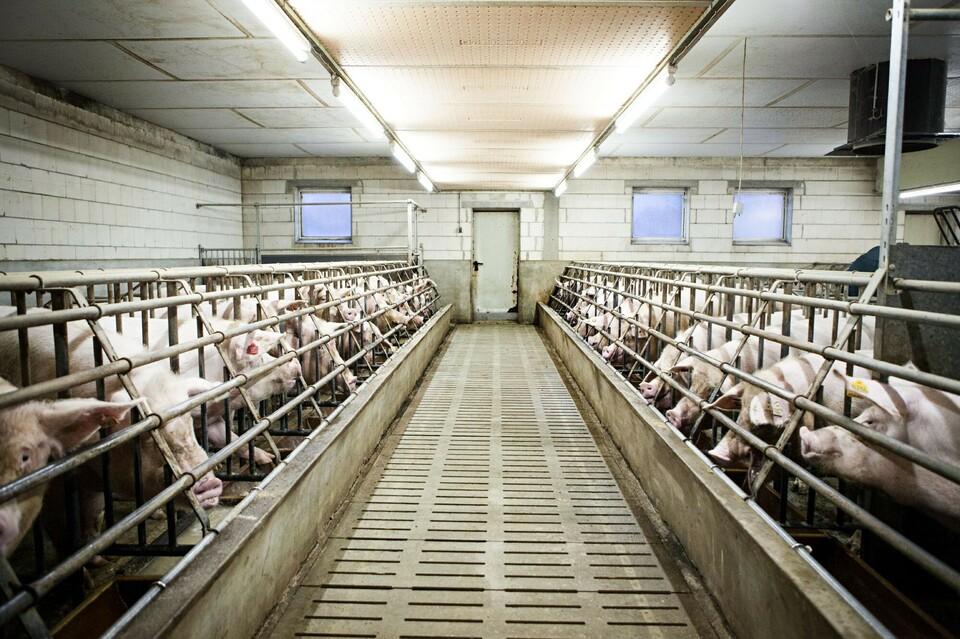
Sow stalls
How the pork industry treats breeding sows
Sows staying in conventional intensive pig farms, spend about half of their lives in tight-fitting metal cages. These crates (sow stalls, farrowing crates) are justified by the industry of supposedly preventing the sow from accidentally crushing the piglets after giving birth. But the real reason is economy – producing as many pigs as possible in the shortest possible time, in the smallest possible space. Sows are not able to move or turn around in these cages. Nest building and social bonding with their piglets is not possible and the sows are forced to lie on hard, concrete floor and in their own faeces.
The problem with sow stalls
A sow is confined in a crate fofr a large part of her 16-week gestation pregnancy period. For 10 weeks in a row, she is trapped in farrowing crates for 1 week before and 4 weeks after giving birth, along with 5 weeks of confinement during and after insemination in individual gestation crates.
Farrowing crates prevent the sow from forming a bond with her piglets – whose behaviour is also severely restricted in this kind of a barren environment2. The concrete floor is not littered, the sow is forced to lie on very hard floor, often leading to severe joint inflammations. The metal rods often cause purulent inflammation of the sows’ shoulders. She is forced to lie down on her excrements which is not only unhygienic during giving birth, but also severely uncomfortable for the otherwise very clean individuals.
The piglets are often trapped in the concrete slats as their feet are very small and the slats are often too big. A few days before giving birth, sows feel a strong urge to build a nest and would use twigs and grass in nature, but the need would also be satisfied by using straw. However, not only they aren't provided with straw, they do not even have the appropriate space to build such a nest, leaving them frustrated and stressed as their natural needs are not met1.

FOUR PAWS opposes the use of sow stalls and farrowing crates.
A sad, repeating cycle
Mother sows are treated like childbearing machines. Their life is an uninterrupted cycle of artificial insemination, pregnancy, farrowing, nursing time and then renewed insemination. A sow can get pregnant two or even three times in a year, with a pregnancy lasting about 114 days, followed by 3-5 weeks of nursing time before the piglets are weaned3. Under natural conditions, piglets would continue to be with their mother until they are gradually weaned at around 4-5 months old.
The problem of weaning before 40 days is actually that the immune system of the piglets is not fully established. The ideal mother-child-bond can only be established if the sow does not have more piglets than teats, which is often not the case in modern breeds (Landrace) who are bred to produce as many piglets as possible, more than the sow can care for. This leads to high mortality rates of underweight piglets usually killed on-farm.
Inseminated at 5-7 months and long periods of isolation
The young females are inseminated for the first time at around 6-8 months.
In intensive indoor farms, the sow is locked in a crate in a 'mating stall' where she is confined and unable to turn around for up to five days after mating. This way the sow can be inseminated through natural mating (using a boar) or artificially at a specific time point that suits the management of the farm. Usually, farmers want to synchronise a whole group of sows and bring them into heat at the same time, so that they can move all of them to a different compartment in their rotating cycle and all production stages are occupied evenly. Once the sows are inseminated, they are usually put in individual sow stalls, where they stay for at least six weeks.
Once the weeks of isolation pass, they are released back to the group, until one week before the farrowing starts, where they will once again be isolated and moved to farrowing crates until their piglets are weaned off after 3-5 weeks.
Giving birth and suckling in extremely tight spaces
The sow is brought to the farrowing pen about a week before the calculated date of birth. There she is crammed into a metal cage for about 5 weeks (a crate in the farrowing pen) in which she gives birth to about 9-13 piglets, and which she nurses for about three to four weeks in most farms, or even less if the farm practices early weaning. In a natural setting, a week after farrowing, the sow would start to introduce her piglets to the herd, then nurse them for about 4-5 months, while socialising with the herd the rest of the time.
The bars in the farrowing crate separate the mother from her piglets. The piglets can reach the teats of the mother under the rods, but the mother cannot make loving contact with her piglets. After piglets are weaned, the sow is usually almost immediately returned to the breeding centre and back to the insemination crate. It is only during her pregnancy, that she is kept in the group with other (pregnant) sows for a few weeks.
Sows give birth until death
A sow goes through this production cycle until it no longer achieves the desired 'reproductive performance' of an average of about 30 piglets per year. Then she is slaughtered. Most sows only survive this cycle for just a few years. The natural life expectancy of pigs would be much higher.
Legal situation in Australia regarding sow stalls
After public outrage, the Australian Pork Industry committed to phasing out sow stalls by 2017, instead keeping sows in loose housing until a week before birth when they are moved to farrowing crates. Despite these assurances however, investigations in 2022 have revealed that sow stalls are still being used across parts of Australia.
Public perception
As more people are becoming aware of the cruelty of farrowing crates, the public pressured many food companies across the globe to promise to push back against farrowing crates that are in use for the production of their meat. Between 2012 and 2015, more than 200 food companies, including restaurant chains like McDonald's, Burger King and Wendy's have surrendered to the consumer demand for more welfare-friendly production6. Most of these companies are expecting to hit their target of crate-free production by 2022, with some already making good on their promise in their EU bases7.
Source
2) https://thepigsite.com/articles/practical-options-for-indoor-freefarrowing-systems
3) http://www.nzdl.org/gsdlmod?e=d-00000-00---off-0hdl--00-0----0-10-0---0---0direct-10---4-------0-1l--11-en-50---20-about---00-0-1-00-0--4----0-0-11-10-0utfZz-8-00&cl=CL1.14&d=HASH012fbc1291f9d347cee97f25.5.1>=1
4) https://thepigsite.com/articles/basic-pig-husbandry-the-weaner
5) Australian Pork [Accessed 16/11/2022] https://australianpork.com.au/about-pig-farming/housing
6) The Guardian [Accessed 16/11/2022] https://www.theguardian.com/world/2022/sep/21/pigs-still-held-in-narrow-pens-industry-promised-to-ban-victorian-animal-justice-party-claims






